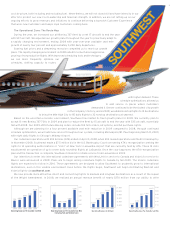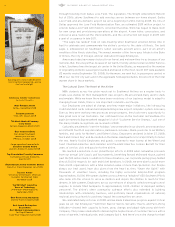Southwest Airlines 2008 Annual Report Download - page 20
Download and view the complete annual report
Please find page 20 of the 2008 Southwest Airlines annual report below. You can navigate through the pages in the report by either clicking on the pages listed below, or by using the keyword search tool below to find specific information within the annual report.
PART I
Item 1. Business
Overview
Southwest Airlines Co. is a major passenger
airline that provides scheduled air transportation in the
United States. Based on the most recent data available
from the U.S. Department of Transportation (“DOT”),
Southwest is the largest air carrier in the United States,
as measured by the number of originating passengers
boarded and the number of scheduled domestic
departures. Southwest commenced Customer Service
on June 18, 1971, with three Boeing 737 aircraft
serving three Texas cities — Dallas, Houston, and
San Antonio. As of December 31, 2008, Southwest
operated 537 Boeing 737 aircraft and provided service
to 64 cities in 32 states throughout the United States.
In 2008, Southwest announced that it would be
commencing service to Minneapolis-St. Paul in March
2009. In addition, Southwest has received initial
approval to acquire 14 take-off and landing slots at
New York’s LaGuardia airport from the former ATA
Airlines, Inc., which filed for bankruptcy protection in
April 2008.
Southwest focuses principally on point-to-point,
rather than hub-and-spoke, service, providing its
markets with frequent, conveniently timed flights and
low fares. As of December 31, 2008, Southwest
served 438 nonstop city pairs. Historically,
Southwest served predominantly short-haul routes,
with high frequencies. In recent years, Southwest has
complemented this service with more medium to
long-haul routes, including transcontinental service.
Southwest has a low cost structure, enabling it
to charge low fares. Adjusted for stage length,
Southwest has lower unit costs, on average, than
most major network carriers. Southwest’s low cost
advantage is facilitated by reliance upon a single
aircraft type, an operationally efficient route
structure, and highly productive Employees.
Fuel Price Impact
Fuel prices can have a significant impact on
Southwest’s profitability. During 2008, the cost of fuel
fluctuated greatly, as the price of a barrel of crude oil
soared from near $100 in January 2008 to almost $150
in July 2008, then plummeted to below $35 at one
point during the fourth quarter of 2008. The table
below shows Southwest’s average cost of jet fuel, net
of hedging gains and including fuel taxes, over the past
five years and during each quarter of 2008:
Year
Cost*
(Millions)
Average
Cost
Per
Gallon*
Percent of
Operating
Expenses*
2004 ................ $1,106 $ .92 18.1%
2005 ................ $1,470 $1.13 21.4%
2006 ................ $2,284 $1.64 28.0%
2007 ................ $2,690 $1.80 29.7%
2008 ................ $3,713 $2.44 35.1%
First Quarter 2008 ..... $ 800 $2.13 32.8%
Second Quarter 2008 . . . $ 944 $2.42 35.5%
Third Quarter 2008 ..... $1,051 $2.73 37.5%
Fourth Quarter 2008 .... $ 918 $2.49 34.5%
* Southwest reclassified fuel sales and excise taxes
for the years 2004 through 2007 from “Other
operating expenses” to “Fuel and oil expense” in
order to conform to the current year presentation.
Average fuel cost per gallon figures, as well as the
percent of operating expenses, have also been
recalculated based on the restated information.
Volatile fuel costs, coupled with a continued
domestic economic downturn, had a significant
impact on Southwest and the airline industry
generally during 2008. The dramatically higher fuel
prices during most of the year led to significant
industry-wide capacity reductions. Southwest’s fuel
hedges during this time enabled it to weather fuel
price increases, contributing to cash savings of
almost $1.3 billion during 2008; however, the recent
significant decline in fuel prices led to Southwest’s
decision to significantly reduce its net fuel hedge
position in place for 2009 and beyond. Southwest’s
fuel hedging activities are discussed in more detail
below under “Risk Factors” and “Management’s
Discussion and Analysis of Financial Condition and
Results of Operations.”
Regulation
The airline industry is heavily regulated,
especially by the federal government. Examples of
regulations impacting Southwest and/or the industry
include:
Economic and Operational Regulation
•Aviation Taxes. The statutory authority for
the federal government to collect aviation
1
























